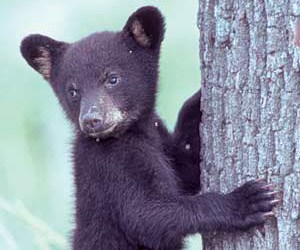What Animals Are Found In Mountaious Areas

Gary Carter Photo
Great Smoky Mountains National Park contains some of the largest tracts of wilderness in the East and is a critical sanctuary for a wide variety of animals. Protected in the park are some 65 species of mammals, over 200 varieties of birds, 67 native fish species, and more 80 types of reptiles and amphibians.
The symbol of the Smokies, the American Black Bear, is perhaps the virtually famous resident of the park. Great Smoky Mountains National Park provides the largest protected comport habitat in the East. Though populations are variable, biologists approximate approximately i,500 bears live in the park, a density of approximately 2 bears per square mile.
Of the 65 other mammal species documented in the park, the white-tailed deer, groundhog, chipmunk, and some squirrel and bat species are the nigh unremarkably seen. Over 200 species of birds are regularly sighted in the park, 85 of those migrate from the neotropics. Some 120 species nest here. Several bird species that are listed every bit Species of Business organisation breed hither, making the park an important source for repopulating areas outside the park that are showing declines in the numbers of these birds.
Surrounded by warm lowlands, the cool, moist, climate of the park's highest elevations creates islands of habitat suitable for animals ordinarily constitute in more northern areas, allowing them to live far s of their nowadays principal ranges. Northern species such as the northern flying squirrel, red squirrel, and stone vole thrive at high elevations, while the Northern Saw-whet Owl, Canada Warbler, Common Raven, and other birds attain their southern most convenance point here in the park.
Over 700 miles of streams in the park support fish. The park boasts over 50 native fish species, including the brook trout, whose fragile habitat is existence wrested from the non-native rainbow and brown trout past agile fisheries management. Depression acme, slower and warmer streams have the greatest aquatic diversity including four reintroduced federally threatened and endangered small fish: the Smoky Madtom, Yellowfin Madtom, Spotfin Chub, and Duskytail Darter.
Smashing Smoky Mountains National Park has been called the "Salamander Capital of the World." Climatic and geologic factors have combined to spur the development of 30 salamander species in five families, making this ane of the most diverse areas on world for this gild. In fact, lungless salamanders have undergone an extraordinary level of evolutionary diversification in the park-24 species inhabit the park, making it the middle of diverseness for the family.
Prior to park establishment in 1934, a number of animals native to the Smoky Mountains were eradicated by hunting, trapping, irresolute country uses, and other causes. Extirpated species include bison, elk, mountain lion, gray wolf, scarlet wolf, fisher, river otter, Peregrine Falcon, and several species of fish. A primary goal of the National Park Service is to preserve the flora and creature of the Smokies in a condition similar to that which existed prior to the arrival of modernistic, technological humans. In accordance with this mission, the National Park Service has helped reintroduce the river otter, elk, and Peregrine Falcon to the Smokies. Learn more about species now missing from the park.
As man activities dominate ever-larger portions of the American landscape, our national parks have become increasingly valuable as sanctuaries for rare and endangered wild animals. Endangered park animals include the northern flying squirrel, Ruddy-cockaded Woodpecker, Indiana bat, spruce-fir moss spider, and the Smoky madtom. View a complete listing of Threatened and Endangered species. The Park Service has been involved in a number of efforts to save these species from extinction. Park resources direction crews accept conducted prescribed fires in old-growth pino-oak wood to create suitable nesting sites for Crimson-cockaded Woodpeckers. Crews have besides erected solid steel barricades at cave entrances to protect endangered bats from spelunkers during disquisitional times of the year. Reintroduction programs have as well increased the survival chances for Smoky madtoms and Peregrine Falcons.
Viewing wildlife in the Smokies can be challenging because virtually of the park is covered by dense wood. Open up areas like Cataloochee and Cades Cove offer some of the best opportunities to see white-tailed deer, black deport, raccoon, Wild Turkey, woodchuck, and other animals. During wintertime, wildlife is more than visible because deciduous trees accept lost their leaves. Since many animals are most active at night, it can be advantageous to look for wildlife during morning and evening. It's also a expert idea to behave binoculars. And don't forget to scan the trees-many animals spend their days among the branches.
Source: https://www.nps.gov/grsm/learn/nature/animals.htm
Posted by: smithbelve1956.blogspot.com

0 Response to "What Animals Are Found In Mountaious Areas"
Post a Comment